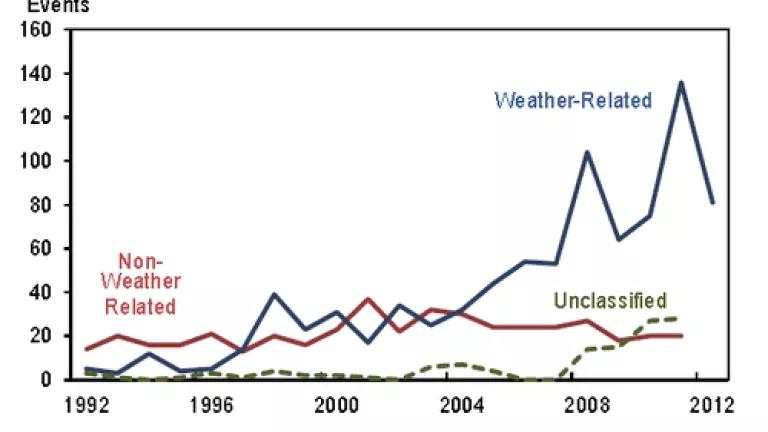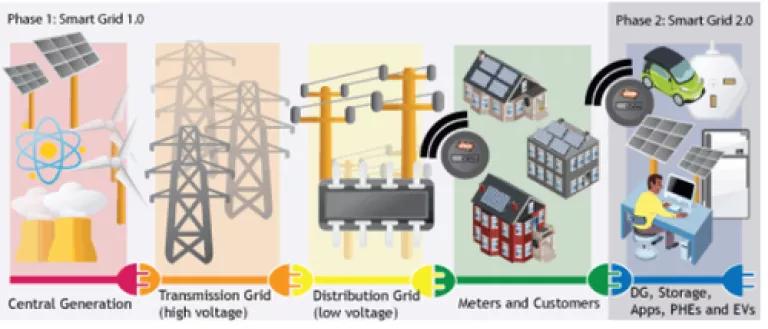
Earlier this week, the president’s office released a report that: describes the costs of weather-related grid outages to the U.S. economy (an average of $18-$33 billion annually since 2003), projects that these outages will get worse thanks to climate change, and tallies the economic benefits of increasing the transmission grid’s resilience – that is, the ability of the grid to “harden,” and recover and reconstitute in the face of severe weather events. The report’s release falls 10 years to the week after the 2003 Northeastern blackout that left 50 million people without power for up to two days; a blackout caused mostly by high demand, equipment failure and human error.
This week’s anniversary, during which many reporters have been asking about whether we could see another blackout like 2003, perhaps has been eclipsed by more recent events, at least for those who have now lived through the Hurricane Sandy blackout and other severe storms. Which goes to one of the points of the president’s report: it is climate change, not a hungry appetite for air conditioning and human error, that will continue to wreak the most havoc on the transmission system (and therefore the power supply to our homes and businesses).
Some Improvements in the Last Decade – But Extreme Weather is a Growing Threat
But first back to the question about whether a 2003-like blackout could happen again. The grid has gotten smarter and more resilient over the last decade, thanks to a lot of cool technology (like phasor measurement units) and hard work by the people responsible for ensuring your lights turn on in the morning and your iPod gets charged at night. Computer systems are providing grid operators real-time information about system conditions that allow them to solve problems before they turn into outages.
At the same time, cities, states and the federal government have also gotten smarter about energy use and, for example, have issued standards that make air conditioners, water heaters and entire buildings more efficient and less stressful on the grid during periods of high demand. So, all other things being equal, it is probably safe to say that outages like the 2003 blackout are less likely a decade later.
But all other things aren’t equal. The president’s report affirms a pretty intuitive point: “the number of outages caused by severe weather is expected to rise as climate change increases the frequency and intensity of hurricanes, blizzards, floods and other extreme weather events.” Although technology is improving the ability to address grid issues caused by trees knocking out individual transmission lines or human mistakes, large scale storms like Hurricane Sandy have the ability to overwhelm the grid in less manageable ways. Hence the report’s call for increased “grid resiliency.”
Cleaner Energy Resources: Good for the Grid, Consumers and Environment
And now for the good news. There are lots of resources that contribute to grid resiliency and flexibility. Happily, they are the same resources that are critical to achieving a clean energy, low carbon future: solar panels on your rooftop, energy savings through more efficient appliances and buildings (yes, savings are a resource – and a cheap one, at that), reductions in electricity use by businesses, manufacturers and individuals in response to grid operator signals (again, a resource), energy storage, and even aggregated groups of electric cars can all contribute to a more flexible and resilient grid. In some cases these resources can allow old, inflexible and usually dirtier fossil fuel generation to retire, or can avoid the development of expensive new transmission.

How do we get more of these resources in place? Check out this blog about a report that I worked on with the Bipartisan Policy Center that contains an extensive list of policy recommendations to support integration of these clean energy resources while maintaining reliability. And here’s another idea. And a few more.
So, it turns out that the clean resources necessary to provide resiliency and flexibility in the face of severe weather are also the cheapest options we have and are also the resources that contribute to reductions in carbon emissions, which in the long run will help to mitigate instances of severe weather. Now that’s what I call “win-win-win.”



